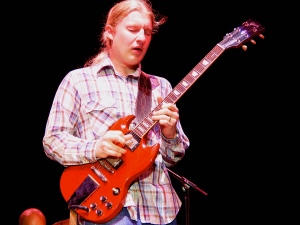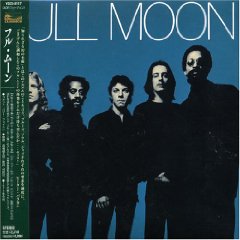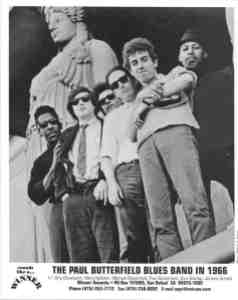I went over to the refurbished Waterbury Palace Sunday to see the Derek Trucks Band. The concert had a vibe that can only be described as straight from the ’60s. That’s what I said to my son, Matthew, who is 11, in between one of the songs of the approximately one-hour, 45-minute set. I told him if he ever wanted to know what it was like to be at a late ’60s concert, this was it.
That appears to be one of the things Trucks and his capable group of musicians intends to achieve each night as they start a long tour of the States this month in support of their recently released album Already Free.
 The setting was perfect for it. The Palace is a proscenium theater, with its newly reupholstered red velvet seats, in all its original ornate glory, particularly the design and decor of the ceiling,walls and balcony of the hall. The light show, projected from the back of the stage, provided stunning yet subtle atmospherics, and the band played a bluesy roots style of music with world and jazz shadings that put the emphasis on inprovisational playing, everything that turned the music and show business in general on its ear from about 1966 to 1969. Probably most important the audience sat and listened to the music for about 90 percent of the show, with the exception of several standing ovations and the encore, unlike the mindless standing throughout an entire concert you find at venues such as The Meadows and even the Oakdale Theater.
The setting was perfect for it. The Palace is a proscenium theater, with its newly reupholstered red velvet seats, in all its original ornate glory, particularly the design and decor of the ceiling,walls and balcony of the hall. The light show, projected from the back of the stage, provided stunning yet subtle atmospherics, and the band played a bluesy roots style of music with world and jazz shadings that put the emphasis on inprovisational playing, everything that turned the music and show business in general on its ear from about 1966 to 1969. Probably most important the audience sat and listened to the music for about 90 percent of the show, with the exception of several standing ovations and the encore, unlike the mindless standing throughout an entire concert you find at venues such as The Meadows and even the Oakdale Theater.
The performance was low-key as far as stage presence with very little chatter in between songs, but it was absolutely incendiary during the 12 tunes, many drawn from Trucks’ six studio albums.
Trucks plays slide guitar, with chords mixed in, about 80 percent of the time and he is a master of the technique, perhaps the greatest of his time, along with his friend and collaborator Doyle Bramhall II. In a type of playing that would seemingly have limited technical options available, Trucks, who plays without a pick, never lacks for creativity, using the slide in expressive and unique ways, always balancing melodic development with raging fire.
When he does take it off and plays single string solos as he did on two numbers, he shows just as much improvisational skill and inspiration. In the middle of the set, the band played Alan Toussaint’s Get Out Of My Life, Woman, made popular in the ’60s by the great Paul Butterfield Blues Band, and later John Coltrane’s interpretation of My Favorite Things, both extended versions that saw Trucks soloing single string style with the first perhaps the most interesting and moving solo of the night.
The rest of Trucks band is stellar, including Kori Burbridge, equally adept on an array of keyboards, including Hammond B-3 and clavinet, and flute; Todd Smallie, bass; Yonrico Scott, drums; Mike Mattison, lead vocals; and Count M’Butu, percussion. Several of Burbridge’s solos on keys and his answer backs with Trucks on two tunes were inventive and soulful. His flute playing is at once precise, flowing and technically adept.
The band included their Dylan cover of Down In The Flood from Already Free as the second song of the set, fueled by Trucks’ driving slide rhythm and two songs later played the Eastern flavored Sahib Teri Bandi/Maki Madni, both of which featured melodic lines and solos with strong Indian influences.
Meet Me At The Bottom, a John Lee Hooker song with a riff similar to Rollin’ And Tumblin’, highlighted a lower volume, two-song segment in which both Mattison and Trucks sat at the front of the stage. They closed the main set with a ripping version of Sleepy Johns Estes’ Leavin’ Trunk, made popular by Taj Mahal on his first album in the ’60s, and the encore was the title tune from Soul Serenade.
The evening was sheer pleasure as we were transported back to a time when music, performance and creativity were the order of the day. Nice to be reminded of it.
The set list:
I Know
Down In The Flood
Crow Jane
Sahib Teri Bandi/Maki Madni
Get Out Of My Life, Woman
Already Free
Meet Me At The Bottom
Blind, Crippled & Crazy
My Favorite Things
We’re A Winner
Leavin’ Trunk
Soul Serenade

 That was one of Ford’s earliest influences and he has kept that foundation of blues and blues-rock alive in his music, combining it with jazz sensibilities to form his own brand of fusion. Throughout his career, he’s played with many diverse, high-caliber musicians from Joni Mitchell to Miles Davis, and Ford’s varied skills have been consistently on display as a solo performer since the late 1980s.
That was one of Ford’s earliest influences and he has kept that foundation of blues and blues-rock alive in his music, combining it with jazz sensibilities to form his own brand of fusion. Throughout his career, he’s played with many diverse, high-caliber musicians from Joni Mitchell to Miles Davis, and Ford’s varied skills have been consistently on display as a solo performer since the late 1980s. My main interest was not in the Director’s Cut, which I had bought back in the early ’90s, but in the Extras disc, Woodstock: Untold Stories. It includes about three hours of material with nearly 150 minutes of previously unreleased performances, the rest consisting of documentary video segments.
My main interest was not in the Director’s Cut, which I had bought back in the early ’90s, but in the Extras disc, Woodstock: Untold Stories. It includes about three hours of material with nearly 150 minutes of previously unreleased performances, the rest consisting of documentary video segments. The only question left is whether Michael Lang, who produced the original festival, will stage anniversary events in August. There were reports earlier this year about free
The only question left is whether Michael Lang, who produced the original festival, will stage anniversary events in August. There were reports earlier this year about free  The self-titled album Full Moon from 1971 fits into this category. Three of its members came from the Paul Butterfield Blues Band, drummer Phillip Wilson and tenor saxman Gene Dinwiddie (billed as Brother Gene Dinwiddie throughout the album’s credits), both of whom joined Butterfield around 1967 for The Resurrection Of Pigboy Crabshaw, and Buzz Feiten, who joined Butter a little later in ’68 replacing guitarist Elvin Bishop. Feiten, who did a stint with the Rascals after Butterfield, was one of the most unusual additions to Butterfield’s band, younger than most of the other players, precocious, almost punk for 1968. He brought a different sound and style and great versatility to the band with his piercing Fender Strat, cut more from a soul vein than blues.
The self-titled album Full Moon from 1971 fits into this category. Three of its members came from the Paul Butterfield Blues Band, drummer Phillip Wilson and tenor saxman Gene Dinwiddie (billed as Brother Gene Dinwiddie throughout the album’s credits), both of whom joined Butterfield around 1967 for The Resurrection Of Pigboy Crabshaw, and Buzz Feiten, who joined Butter a little later in ’68 replacing guitarist Elvin Bishop. Feiten, who did a stint with the Rascals after Butterfield, was one of the most unusual additions to Butterfield’s band, younger than most of the other players, precocious, almost punk for 1968. He brought a different sound and style and great versatility to the band with his piercing Fender Strat, cut more from a soul vein than blues. I’ve been to quite a few concerts over the years, many influential, some inspiring. The earliest big venue shows were in the fall of 1965, both at the New Haven Arena. In early November, it was the Rolling Stones with Brian Jones on second guitar in the wake of their summer mega-hit Satisfaction. The Stones sounded and looked great, but it was a relatively sedate performance compared with ones for which the band became infamous. A side note on the Stones show is that the first time they were booked for the Arena, the summer of ’64, the show was actually canceled because of insufficient ticket sales. Amazing. The second show, the Beach Boys with Brian Wilson on bass, on Thanksgiving Day. The Boys wore yellow short-sleeved oxford shirts with gray slacks, not their customary black-and-white and white khakis (I guess because it was a holiday) and with Brian in the fold sounded like angels. Two rather different groups but both rode the singles charts and that’s what drove the music industry at the time.
I’ve been to quite a few concerts over the years, many influential, some inspiring. The earliest big venue shows were in the fall of 1965, both at the New Haven Arena. In early November, it was the Rolling Stones with Brian Jones on second guitar in the wake of their summer mega-hit Satisfaction. The Stones sounded and looked great, but it was a relatively sedate performance compared with ones for which the band became infamous. A side note on the Stones show is that the first time they were booked for the Arena, the summer of ’64, the show was actually canceled because of insufficient ticket sales. Amazing. The second show, the Beach Boys with Brian Wilson on bass, on Thanksgiving Day. The Boys wore yellow short-sleeved oxford shirts with gray slacks, not their customary black-and-white and white khakis (I guess because it was a holiday) and with Brian in the fold sounded like angels. Two rather different groups but both rode the singles charts and that’s what drove the music industry at the time. The setting was perfect for it. The Palace is a proscenium theater, with its newly reupholstered red velvet seats, in all its original ornate glory, particularly the design and decor of the ceiling,walls and balcony of the hall. The light show, projected from the back of the stage, provided stunning yet subtle atmospherics, and the band played a bluesy roots style of music with world and jazz shadings that put the emphasis on inprovisational playing, everything that turned the music and show business in general on its ear from about 1966 to 1969. Probably most important the audience sat and listened to the music for about 90 percent of the show, with the exception of several standing ovations and the encore, unlike the mindless standing throughout an entire concert you find at venues such as The Meadows and even the Oakdale Theater.
The setting was perfect for it. The Palace is a proscenium theater, with its newly reupholstered red velvet seats, in all its original ornate glory, particularly the design and decor of the ceiling,walls and balcony of the hall. The light show, projected from the back of the stage, provided stunning yet subtle atmospherics, and the band played a bluesy roots style of music with world and jazz shadings that put the emphasis on inprovisational playing, everything that turned the music and show business in general on its ear from about 1966 to 1969. Probably most important the audience sat and listened to the music for about 90 percent of the show, with the exception of several standing ovations and the encore, unlike the mindless standing throughout an entire concert you find at venues such as The Meadows and even the Oakdale Theater.